hotrod jigs
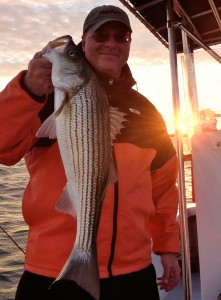 What has been will be again,
What has been will be again,
What has been done will be done again;
There is nothing new under the sun -Ecclesiastes 1:9
Since Candy Thomson published an article about my favorite jigging technique in today’s Baltimore Sun, I thought I might talk about it a little more. First, thanks to Candy for the nice write-up. She had originally planned to fish with us, but unfortunately broke a finger in a kayak accident a couple of days before. She decided to come along anyway and it was great having her, Joe, and Colin on Thunder Road for a fun evening of catching. I’m a big fan of Candy’s Outdoors Girl blog. I don’t always agree with her, but I never miss an entry. There’s no question that, despite the splint she’s wearing lately, she has her finger squarely on the pulse of outdoor issues in Maryland.
I’ll start this article by stating the obvious in that casting artificial lures for stripers using outfits made for freshwater black bass is nothing new – my father taught me to catch stripers using bass lures when I was very young. I had never heard of using heavy duty saltwater trolling gear for rockfish until I moved from Tennessee to Maryland. I was amazed and somewhat amused the first time I saw a twenty-five rod planer board trolling spread. Read More!
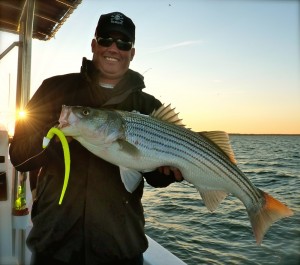 This week I’ve been fishing both north and south of Kent Island. I’m running along the deeper ledges looking for big birds either diving on breaking fish, flying high, or sitting. Since the fall turnover, the better fish have been feeding deep, sometimes thirty five feet deep or more. Once they round up a school of four to six inch bunker, they force them to the surface then explode into them knocking the hapless baitfish into the air where the gulls are waiting. The fish aren’t breaking in big pods but moving around in twenty to thirty fish rat packs. I usually only see a few splashes here and there to send down the birds. The predators move on quickly, so by the time you get to where you saw the splashes, they’re usually gone. The trick to catching them is to figure out what is attracting them to the location and try to anticipate their next move. While migratory stripers will feed wherever they find baitfish, this time of year they’re still running with Chesapeake residents so it’s more likely they are relating to underwater structure. That structure will probably be a live hard bottom near a steep subsurface ledge, especially ledges located near the mouths of tributary rivers. So when big fish are breaking here and there and not really schooled up, the best bet is to simply set up a drift near the ledge and wait for them to come to you. Read More!
This week I’ve been fishing both north and south of Kent Island. I’m running along the deeper ledges looking for big birds either diving on breaking fish, flying high, or sitting. Since the fall turnover, the better fish have been feeding deep, sometimes thirty five feet deep or more. Once they round up a school of four to six inch bunker, they force them to the surface then explode into them knocking the hapless baitfish into the air where the gulls are waiting. The fish aren’t breaking in big pods but moving around in twenty to thirty fish rat packs. I usually only see a few splashes here and there to send down the birds. The predators move on quickly, so by the time you get to where you saw the splashes, they’re usually gone. The trick to catching them is to figure out what is attracting them to the location and try to anticipate their next move. While migratory stripers will feed wherever they find baitfish, this time of year they’re still running with Chesapeake residents so it’s more likely they are relating to underwater structure. That structure will probably be a live hard bottom near a steep subsurface ledge, especially ledges located near the mouths of tributary rivers. So when big fish are breaking here and there and not really schooled up, the best bet is to simply set up a drift near the ledge and wait for them to come to you. Read More!
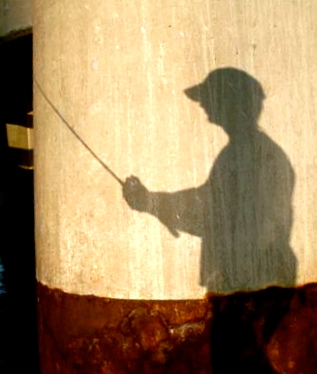 Summertime,
Summertime,
And the livin’ is easy
Fish are jumpin’
And the cotton is high
If I could add a line to George Gershwin’s song, it would be “and the piling bite is on.” This week marked the start of the summer pattern around the William Preston Lane Jr. Memorial Bridge. The migratory fish are long gone, the bluefish are moving in, and the resident rock have set up shop around the pilings. This is the time of year when it’s well-worthwhile to make a sunset run out of Matapeake to drop a jig around the rockpiles or toss a top-water plug over the Pipe. Go, even if there’s only a few minutes to fish. It’s the closest to a sure thing the Chesapeake has to offer. Better yet, the big white perch are out of the rivers and hanging out in the shallow water around the bridge. My wife and I ate fresh fish three times this past week. Back in the South, we’d call that steppin’ in high cotton. Here, it’s just a summer week on the Bay. Read More!
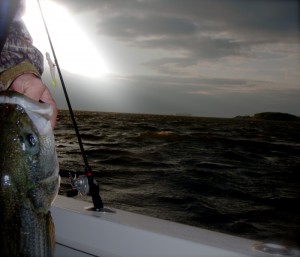 I admit it, I dread the opening day of rockfish kill season like a vampire dreads a tossed salad. In my book, it’s the beginning of the end of good fishing on the Chesapeake Bay. With one stroke of the clock our tranquil miles of open-Bay solitude are overrun by frantic hoards of frenzied fishermen. The meat fleet is out in force on boats bristling with rods the size of rake handles and dozens of lines spread out hundreds of feet using planer board rigs. Lost somewhere in the melee is the concept of one-man-one-rod sportsmanship. To make matters worse, the Department of Natural Resources sets the opening of the kill season while there are still pre-spawn fish in the Bay. Big cows are routinely killed before they have a chance to spread the millions of eggs they are carrying. Maryland, we are sucking the life-blood out of the sport we love by killing our spawning fish. Read More!
I admit it, I dread the opening day of rockfish kill season like a vampire dreads a tossed salad. In my book, it’s the beginning of the end of good fishing on the Chesapeake Bay. With one stroke of the clock our tranquil miles of open-Bay solitude are overrun by frantic hoards of frenzied fishermen. The meat fleet is out in force on boats bristling with rods the size of rake handles and dozens of lines spread out hundreds of feet using planer board rigs. Lost somewhere in the melee is the concept of one-man-one-rod sportsmanship. To make matters worse, the Department of Natural Resources sets the opening of the kill season while there are still pre-spawn fish in the Bay. Big cows are routinely killed before they have a chance to spread the millions of eggs they are carrying. Maryland, we are sucking the life-blood out of the sport we love by killing our spawning fish. Read More!
 If the tail slaps of big rockfish can be compared to the rumble of a Chesapeake storm, I spent this past weekend riding on thunder road. We’re seeing the first signs of spring on the Bay resulting in some fun fishing. The good times this weekend were especially sweet because I just took delivery of my new Judge 27CC. If you’ve followed my website you know I’ve been looking for a new boat for some time. There are several reasons why I chose the Judge. First off, I’m used to a long boat. Having fished out of the Sea Ray for three years, I wanted something of similar length and handling so I could continue to go out in rough weather. I also needed a boat with a relatively narrow beam so I can trailer to where the fish are without worrying about permits. My other priorities included a bass boat style casting platform, a place to duck in out of the weather or sleep in emergencies, a shallow draft for fishing the near-shore top-water spots, and a long comfortable warranty. Of course price played a major role. I narrowed my decision down to three brands and Bill Judge made me the best deal even after the modifications I needed. There’s a lot to be said for cutting out the middle-man and buying directly from the boat builder, especially when it’s a local Eastern Shore guy.
If the tail slaps of big rockfish can be compared to the rumble of a Chesapeake storm, I spent this past weekend riding on thunder road. We’re seeing the first signs of spring on the Bay resulting in some fun fishing. The good times this weekend were especially sweet because I just took delivery of my new Judge 27CC. If you’ve followed my website you know I’ve been looking for a new boat for some time. There are several reasons why I chose the Judge. First off, I’m used to a long boat. Having fished out of the Sea Ray for three years, I wanted something of similar length and handling so I could continue to go out in rough weather. I also needed a boat with a relatively narrow beam so I can trailer to where the fish are without worrying about permits. My other priorities included a bass boat style casting platform, a place to duck in out of the weather or sleep in emergencies, a shallow draft for fishing the near-shore top-water spots, and a long comfortable warranty. Of course price played a major role. I narrowed my decision down to three brands and Bill Judge made me the best deal even after the modifications I needed. There’s a lot to be said for cutting out the middle-man and buying directly from the boat builder, especially when it’s a local Eastern Shore guy.
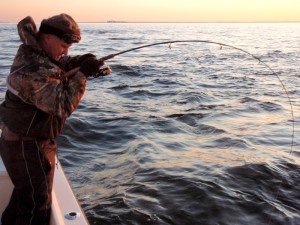 I’ve mentioned in previous reports that there are an extraordinary number of striped bass in the Bay this winter. It’s never been unusual to find a few big fish here and there during cold weather, but each year there seem to be more nice fish wintering over. I’ve managed a couple of trips this week with very good results as you can see in the photos below. Curious about why there are so many January rockfish, I put the question to Maryland Department of Natural Resources Senior Fisheries Biologist “Rockfish” Rudy Lukacovic when I ran into him at the Boatyard Bar & Grill in Annapolis one evening this week. Rudy thinks it’s all a part of changing migration patterns. He also noted that there have been fewer fish in the usual wintering grounds off the coast of the Carolinas in recent years. Read More!
I’ve mentioned in previous reports that there are an extraordinary number of striped bass in the Bay this winter. It’s never been unusual to find a few big fish here and there during cold weather, but each year there seem to be more nice fish wintering over. I’ve managed a couple of trips this week with very good results as you can see in the photos below. Curious about why there are so many January rockfish, I put the question to Maryland Department of Natural Resources Senior Fisheries Biologist “Rockfish” Rudy Lukacovic when I ran into him at the Boatyard Bar & Grill in Annapolis one evening this week. Rudy thinks it’s all a part of changing migration patterns. He also noted that there have been fewer fish in the usual wintering grounds off the coast of the Carolinas in recent years. Read More!


